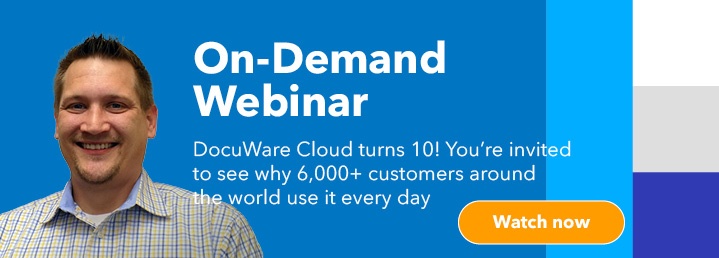In today's fast-paced business world, time has never been more valuable. The bigger your team, the tougher it can be to manage time effectively. But even small- to medium-sized businesses can benefit from the tools offered by an Enterprise Content Management (ECM) system.
ECM systems empower businesses of all sizes to save time and money by digitizing paper documents, capturing electronic documents and email, automating document-driven processes, and ensuring that the right people get access to the information they need, whenever and wherever they need it.
Here are some tips on how you can use your ECM software's tools to save time and money.
1. Electronic signature
What it does:
Just as you’d assume from the name, electronic signature refers to any of a number of processes by which a document can be signed digitally. Using electronic signatures is standard practice these days as they are now considered legally valid in many situations. DocuWare Signature Service ensures that your documents are digitally signed by a verified Trust Service Provider.
How it saves you time or money:
Requiring physical signatures is phenomenally inefficient. For starters, the process requires a physical copy which must be mailed or otherwise delivered to and from the signer. The signed document must then be scanned to be filed and archived.
By using digital signatures, you cut out a number of unnecessary steps significantly reducing the risk of human error in the process. A digitally signed document won’t be misplaced, and even more significantly, a transaction waiting for a signature won’t be held up for days as the document moves from place to place.
By using digital signatures, you cut out a number of unnecessary steps significantly reducing the risk of human error in the process. A digitally signed document won’t be misplaced, and even more significantly, a transaction waiting for a signature won’t be held up for days as the document moves from place to place.
2. Remote access to critical documents
What it does:
By using an ECM, all critical business documents are stored in a centralized location that can be accessed from anywhere by employees who have the required credentials. In other words, a document can be opened whenever an employee needs it without taking time to request it from someone else.
How it saves you time or money:
Having the ability to access documents remotely allows your employees to collaborate on the fly, making your organization nimbler and more responsive. It also affords you the opportunity to address customer concerns more quickly, leading to improved customer satisfaction and retention. But there are some future-proofing benefits here too.
Surveys conducted by the freelance talent marketplace UpWork in 2019, 2020, and June 2021 found that pre-pandemic, companies expected that 38% of their workforce would be fully remote in five years, while in 2021 they expected 58% of employees to be fully remote in that timeframe. The job market continues to shift toward providing remote and hybrid options, and highly-qualified job seekers who demand this flexibility are becoming even more selective when choosing where to work.
In short: it has never been more important to ensure that your company is an attractive place to work, and remote document access is a crucial part of that. Employees who prefer to work from home will look for a job elsewhere if your company isn’t able to offer them that particular perk.
Surveys conducted by the freelance talent marketplace UpWork in 2019, 2020, and June 2021 found that pre-pandemic, companies expected that 38% of their workforce would be fully remote in five years, while in 2021 they expected 58% of employees to be fully remote in that timeframe. The job market continues to shift toward providing remote and hybrid options, and highly-qualified job seekers who demand this flexibility are becoming even more selective when choosing where to work.
In short: it has never been more important to ensure that your company is an attractive place to work, and remote document access is a crucial part of that. Employees who prefer to work from home will look for a job elsewhere if your company isn’t able to offer them that particular perk.
3. Recruitment, job applications and onboarding
What it does:
Speaking of hiring, the process itself is streamlined significantly with an ECM. Enterprise content management systems include tools for processing job applications and onboarding paperwork digitally, allowing applicants and new employees to submit their materials through a single portal.
In addition, web forms offer a user-friendly way to collect accurate data. You can be sure the data is correct because you’ve shifted data entry to the information source. There is built-in conditional logic that directs form completion based on the data a user enters. If they answer “yes” to a question, the form gives them more details. If they answer “no,” the unnecessary fields do not clutter screen real estate. Electronic forms yield sortable results as well allowing you to rule out applicants lacking necessary skills or credentials.
How it saves you time or money:
Any process that turns a paper-based task into an automated and digital one reduces time spent on manual tasks and increases efficiency. In particular, though, handling job applications through your ECM allows you to cast a wider net, both because the application process is frictionless and because the centralized database of job applications that it yields reduces the time it takes to process them.
Having new hires complete onboarding paperwork digitally can pay dividends too. It helps to ensure that they start their new position unburdened by the frustration or burnout that can result from filling out mountains of forms and typing the same information over and over again. Alleviating that kind of negative experience before they begin helps your company’s new employees stay motivated and adapt to their new workplace more quickly.
4. Invoice processing
What it does:
With automated invoice processing, invoices are captured, digitized and indexed before being routed through preconfigured workflows to be approved, paid and archived in a searchable, centralized repository.
How it saves you time or money:
Processing invoices manually is time-consuming, requiring multiple employees to shepherd documents through the process and risking data loss or introducing errors along the way. In switching to an ECM that facilitates automated invoice processing, your company saves significantly on the expenses associated with managing data manually, with invoices now moving through the process without human intervention. Not to mention that you can take advantage of early payment discounts, too.
5. Integration with email and other applications
What it does:
As a comprehensive solution for document management, an ECM allows you to store and access every kind of data and documentation in one location. There are many other advantages as well. Email programs were designed for communication, not for organized storage, security or quick searchability. If you have a tough time finding information stored in an email, you need an ECM solution that includes an email management component and integrates with Microsoft Outlook and other email programs.
Without office automation, tasks are often interrupted employees need to switch programs in order to find relevant information. Modern ECMs can create simple integrations with other applications so that, for example, related documents pop up on the screen of your ERP or accounting software with one click.
How it saves you time or money or both:
According to a survey conducted by Foundry, 91% of business organizations have adopted or plan to adopt a digital-first strategy, with 52% of them reporting that they’d already begun doing so. Adopting a modern ECM and integrating it with the applications you use every day is a key part of staying ahead of that trend.
6. Automated workflow
What it does:
Automated workflow within ECMs takes the manual processes out of critical business tasks, allowing you to apply business rules and route documents automatically. Information that may otherwise be out of reach for those who need it. With ECM, a document is instantly accessible to everyone who has permission to view or edit it.
How it saves you time or money or both:
Manual processes often lead to bottlenecks. A document can sit for days awaiting the next step, only for someone to realize that it never got in front of the right person. With automated workflow, you can be sure that a document is routed correctly and delegate their responsibility to another team member if an employee is out of the office. The system will also send reminders if action isn’t taken within a set timeframe.
Moreover, an automated workflow managed by an ECM guarantees that version management eliminates confusion caused by circulating paper documents or relying on email to collaborate on contracts, policies and other projects. Having a single copy of a centrally-located document that is checked out by one person at a time and read-only for everyone else means never again facing the issue of compiling changes manually or accidentally relying on outdated information.
Moreover, an automated workflow managed by an ECM guarantees that version management eliminates confusion caused by circulating paper documents or relying on email to collaborate on contracts, policies and other projects. Having a single copy of a centrally-located document that is checked out by one person at a time and read-only for everyone else means never again facing the issue of compiling changes manually or accidentally relying on outdated information.
7. Paperless processes
What they do:
The benefits of going paperless are boundless. As mentioned above, remote access to critical documents future-proofs your business in an economy that increasingly trends toward remote work, allowing employees to work from anywhere while maximizing their contribution to your business goals.
How they save you time or money or both:
According to Roadrunner, the average office worker uses 10,000 sheets of paper annually. When you consider the cost of the paper itself and the ink used to print on it, the cost savings of going paperless add up. But when you factor in the inefficiencies caused by misplaced paper documents, duplication of effort, and information that cannot be accessed remotely, it truly becomes a no-brainer.
If you want to know more about the benefits of ECM, download our ebook, Going Paperless in 90 Days now.



